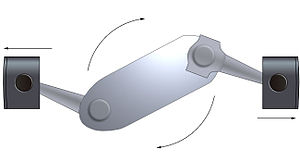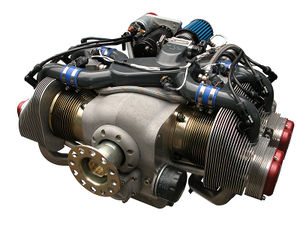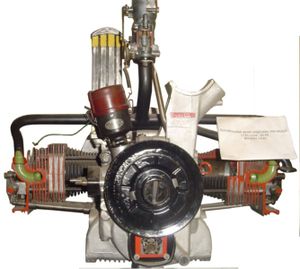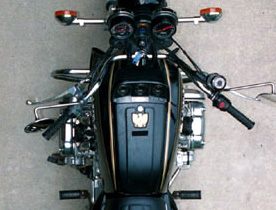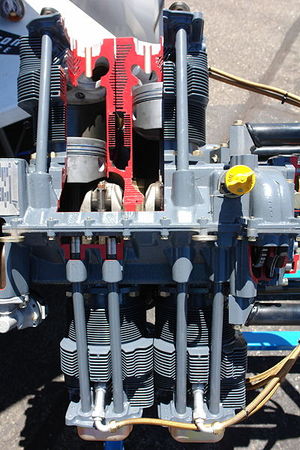Flat engine
A flat engine is an internal combustion engine with pistons that are all relatively horizontal. A straight engine canted 90 degrees from straight up is a flat engine, as is one in which the cylinders are arranged in two banks on either side of a single crankshaft. In both configurations, the motion of all the pistons is in the horizontal plane.
Usually, each pair of corresponding pistons from each bank of cylinders share one crank pin on the crankshaft, either by master/slave rods or by two ordinary rods side by side. Some authorities divide flat engines into boxer engines which do not share crank pins in this way, and 180° engines which do.
- The boxer engine (also known as a horizontally opposed cylinder engine) in which the corresponding pistons reach top dead center simultaneously. Boxer engines should not be confused with opposed piston engines, which use a completely different concept.
- The 180° V engine, in which corresponding pistons share a crank pin on the crankshaft, and thus each will reach top dead center half a crankshaft revolution after the other. Flat engines with more than eight cylinders are most commonly V engines.
German engineer Karl Benz patented his design for the first internal combustion engine with horizontally opposed pistons in 1896.
Configuration
Flat engines are shorter than in-line engines, and have a lower center of gravity than any other common configuration. Automobiles and motorcycles powered by a flat engine generally have a lower center of gravity, giving better stability and control. These engines, however, are also wider than more traditional configurations and are more expensive to build. The extra width may cause problems fitting the engine into the engine bay of a front-engined car owing to the interference with the steering wheels, and create cornering problems for a motorcycle.
The flat configuration also lends itself very well with air cooling and aircraft engines. Air-cooled designs such as in the VW Beetle used a flat-4, as did the Porsche 356 and 912. The Chevrolet Corvair used an air-cooled flat-6, a rarity in American designs. Both the older and newer models of the Porsche 911 use a flat-6, at first air cooled but later models are water-cooled. These automobiles situate the engine in the rear rather than the front, where its width does not interfere with the steering of the front wheels.
Front-mounted air-cooled flat-twin engines were used by Citroën in their model 2CV and its derivatives, while the Citroën GS, Citroën GSA, Oltcit used a flat-4, and a flat-6 was proposed for the Citroën DS, but rejected. BMW uses an air-cooled or partially oil-cooled flat-twin in many of its motorcycles.
All versions of the Subaru Impreza, Forester, Tribeca, Legacy and SVX use either a flat-4 or flat-6 engine.
Boxer engines
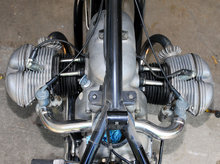
Boxer engines got their name because each pair of pistons moves simultaneously in and out rather than alternately, like boxers showing they're ready by clashing their gloved fists against each other before a fight. Boxer engines of up to eight cylinders have proved highly successful in both automobiles and motorcycles, and continue to be popular for light aircraft engines.
One benefit of using a boxer engine versus a V-engine is that the design provides good balance because each piston's momentum is counterbalanced by the corresponding piston movement of the opposite side. Boxers are one of only three cylinder layouts that have a natural dynamic balance; the others being the straight-6 and the V12. These engines can run very smoothly and free of unbalanced forces with a four-stroke cycle and do not require a balance shaft or counterweights on the crankshaft to balance the weight of the reciprocating parts, which are required in other engine configurations. Note that this is generally true of boxer engines regardless of the number of cylinders (assumed to be even), but not true for all V and straight, or inline engines. However, in the case of boxer engines with fewer than six cylinders, unbalanced moments (also known as a "rocking couple") are unavoidable due to the "opposite" cylinders being not exactly opposite but offset slightly.
Boxer engines tend to produce more noise than inline and V-engines because valve clatter is not so well dampened due to lack of covering by air-filters and other components, and produce a larger torsional vibration than a V-engine, and so tend to require a larger flywheel. They have a characteristic smoothness throughout the rev range and, combined with the mounting position immediately ahead of the rear axle, offer a low center of gravity and more neutral handling.
180° V-engines
Non-boxer flat engines have been used in performance and racing cars, notably 180 degree V12s. Ferrari used a 180° version of the Colombo V12 in the Testarossa and Berlinetta Boxer models. The Porsche 917 flat 12 engine is also not a boxer.
This configuration is sometimes termed a 180° V engine because like most other V engine layouts each pair of pistons share a crank pin. In a 180° V engine when one piston of a pair is at Top Dead Centre the other will be at BDC. In a boxer engine a pair of pistons will be on crank pins 180° apart so that both pistons in a pair will be at TDC at the same time.
Notable flat engines
- In 1896, Karl Benz invented the first internal combustion engine with horizontally opposed pistons
- In 1923 Max Friz designed the first BMW motorcycles, choosing a 500 cc boxer engine and unit transmission with shaft drive. This engine type is still in production today. The BMW 247 engine, known as an airhead due to its air cooling, was produced until 1995. BMW replaced it with the oilhead engine with partial oil cooling and four valves per cylinder, but still retaining the same boxer twin configuration.
- In 1948 Preston Tucker modified a helicopter flat-6 to be rear mounted in his Tucker Torpedo
- The Volkswagen air-cooled flat-4 engine used in the Volkswagen Beetle, SP2 and Karmann Ghia, and later developed further for the Volkswagen Type 2 (Bus) transporters and Volkswagen Type 3 cars
- The Citroën 2CV and Panhard air-cooled flat-2 engines, both influenced by the flat-2s of BMW
- The air-cooled Chevrolet Corvair flat-6
- In 1960 Lancia's flat-4 water-cooled engine debuted for the Lancia Flavia model, first Italian front-wheel drive car, like 1500cc (90 bhp din coupè version) and during the years become a 2.000 cc with 142 bhp ({{rnd/cExpression error: Unexpected < operator.decExpression error: Unexpected < operator.|Expression error: Unexpected < operator.|(Expression error: Unrecognized punctuation character "[".)}} kW)Template:Convert/test/Aon Sae when was mounted the first electronic Injection by Bosch in 1970 in a flat four engine, Lancia also rebuild a new big flat-4 engine in 1976, 2484 cc, for his upper size model Lancia Gamma, this engine was also tested by Squadra Corse Lancia in 1978 with 16 valves and Turbo supercharged, over 300bhp, forRacing Car Lancia Beta Montecarlo prototype (car after becomes World Champion of Makes in 1979 with a different engine). Last Flat-4 engine by Lancia was produced in 1984 on final production of Lancia Gamma, replaced by new Lancia Thema
- The flat-4 engines in Alfa Romeo's Alfasud, Sprint, 33 and early versions of the 145. The last of the line was a 1712 cc flat-4, 16 valves, producing up to 137bhp.
- The water-cooled front-mounted flat-4 and flat-6 engines used by Subaru in all of its mid-sized cars; Subaru refers to these as boxer engines in publicity commentary, and include a variety of naturally aspirated and turbo driven engines; in their turbo engines from 1983 to current, both closed and semi-closed short blocks have been used. Subaru also offer the world's first boxer turbodiesel.
- Since its introduction in 1975, the Honda Goldwing has utilized a boxer style engine, a 4-cylinder until 1987, and 6-cylinders since.
- The water-cooled SOHC 1832 cc flat-6 is fitted to the Honda Goldwing from 2001 on.
- The air-cooled flat-4, flat-6 and flat-8 engines were used for many years in early Porsches. The flat-12 in Porsche's famous 917's is a 180° V-engine and not a boxer.
- The water-cooled flat-6 engines in the Porsche Boxster, Cayman and later 911 models
- General aviation aircraft often use air-cooled flat-4 and flat-6 engines made by companies such as Lycoming, Continental and Rotax.
See also
Flat engine designs
Other engine designs
| Piston engine configurations | |
|---|---|
| Straight | Single, 2, 3, 4, 5, 6, 8, 9, 10, 12, 14 |
| V | 2, 4, 5, 6, 8, 10, 12, 16, 20, 24 |
| Flat | 2, 4, 6, 8, 10, 12, 16, H |
| W | 8, 9, 12, 16, 18 |
| Other inline | H, VR, Opposed, U (Square), X |
| Other | Hemi, Radial, Rotary, Pistonless, Deltic, (Wankel) |
| Heat engines | |
|---|---|
| Stroke cycles One • Two • Four • Six • | |
| Engine types Gas turbine • Piston • Jet • Rocket engine • Steam engine • Stirling engine • Tschudi• Twingle Rotary • Wankel • Free-piston • Britalus • Coomber • Swing-piston • Orbital • Quasiturbine | |
| Valves Cylinder head porting • D slide • Four-stroke • Manifold • Multi • Piston • Poppet • Sleeve | |
| Piston layouts Single cylinder • Straight • Opposed • Flat • V • W • H • Deltic • Radial • Rocket engine nozzle • Rotary • Stelzer • Controlled Combustion • Bourke | |
| Motion mechanisms Cam • Connecting rod • Coomber rotary • Crank • Crank substitute • Crankshaft • Linkages (Evans • Peaucellier-Lipkin • Sector straight-line • Watt) • Double acting/differential cylinder | |
| Thermodynamic cycle |
